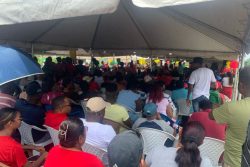Much like the polymer it was named for, Plastic City seems destined to be a forever issue. It is appalling and mind-boggling that after more than three decades, the government is either unable, unwilling or incapable of truly getting a handle on it.
One would be hard pressed to say exactly when squatting on the muddy, garbage-strewn West Demerara foreshore amid a swampy forest of mangroves became such an attraction. However, research indicates that it began with a few families and that the first shacks were tent-like and actually mostly plastic. Currently, there are some houses constructed of concrete, and others that are a mix of reclaimed materials, including wood and zinc. As none of these dwellings were erected with permission from the authorities, there was no planning and hence zero infrastructure in place. The ‘city’ attached to the name is in fact a euphemism for squatter settlement.
Obviously, the area was never intended for housing, given its uncomfortable proximity to the Atlantic Ocean. It was therefore perturbing to learn last week, according to Minister of Housing and Water Collin Croal, that the government was contemplating the regularisation of Plastic City and weighing it against relocation of the squatters. When and why regularisation became a consideration is perplexing indeed. What it will do, if that is the route taken, is set a dangerous precedent. Moreover, at a time like this, when climate change is causing no end of abnormal weather and flooding, greenlighting a waterfront settlement is equivalent to begging for trouble.
In early 2009, as a then newly anointed minister with the portfolio of Housing and Water, President Irfaan Ali had declared his intention to tackle squatting, which was then and remains now, out of control in Region Three (West Demerara-Essequibo Islands). “We have a very strict policy of squatting and we are going to enforce it… We have encouraged people to apply for house lots… We are going to deal conclusively with the issue of squatting now,” a Government Information Agency (GINA) press release had quoted Mr Ali as declaring in March 2009.
He doubled down on this a year later, announcing a strict zero tolerance policy on squatting in Region Three that would see no negotiations or compromises, and singling out the squatters on the National Drainage and Irrigation Authority’s (NDIA) reserve in Stanleytown, Plastic City and Skull City for special mention. GINA quoted Mr Ali as stating: “This year would see a lot of aggression in terms of dealing comprehensively with the issue of squatting.” He had added that his ministry was considering formalising an inter-agency task force with the Central Housing and Planning Authority, the NDIA, the Ministry of Public Works’ Sea Defence Unit and the Regional Administration that would monitor areas to ensure that other squatters did not move in after they were cleared.
Swooping into Skull City, La Grange, West Bank Demerara, with the results of an occupational survey in hand, he had informed its residents that not all of them would be allowed to remain once the area was regularised. This was because some of them had built their shacks in the burial ground. It took years, but Skull City was eventually reconfigured as a housing settlement in 2014. Those residents who were literally living among the skulls were relocated.
With regard to Plastic City, the Ministry of Hous-ing and Water had undertaken a study which concluded that no one could be allowed to live there permanently. Mr Ali had indicated at the time, through GINA, that there would be a phased removal of all the families living in Plastic City over a period of three months. The GINA press release on the issue had quoted him as saying: “The area cannot be regularised. They are living on the boundaries of the sea and as a result of changing weather patterns, climatic conditions and issues of global warming, the government is taking a proactive approach to ensure the well-being of the people.” This was in July 2009. From then to now, climatic conditions have intensified a hundredfold, which makes the current talk of regularisation extremely perplexing.
During 2011 and 2012, some of the original inhabitants of Plastic City began moving on, having been granted houselots elsewhere. Among the 20-odd families who remained, some had applied but not received any houselots, some said they were unable to afford the prices quoted and a few seemed determined to stay, regardless. They had renewed their pleas to the government to give them access to electricity and potable water.
Fast forward to today and there are some 200 families wallowing in the squalid circumstances that constitute Plastic City. In the intervening years, no doubt emboldened by the government’s softly, softly approach, despite its claims of zero tolerance on squatting, many people moved to Plastic City, taking the places of those who had left and adding even more shacks. Some years ago, a mother of four living in Plastic City had spoken to this newspaper about having “purchased a house” there. Untenable before, the situation is now completely unacceptable.
In the configuration of ‘One Guyana’ as constantly touted by President Ali, Plastic City somehow falls outside of the lines. Dealing with the squatting there has meandered over the years from a wishy-washy strategy to what now appears to be a form of surrender on the part of the government and an incomprehensible inability to see the obvious. Plastic City is a disaster that has already occurred. The government’s continued intransigence on completely shutting it down is akin to courting catastrophe.






